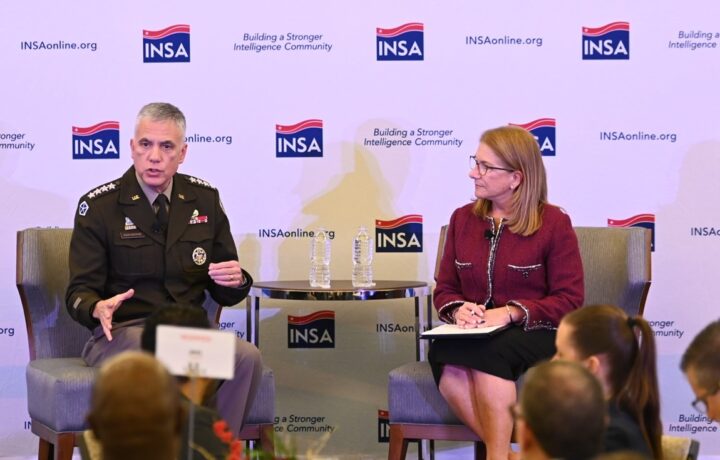The Director of the National Security Agency (NSA) and Commander, U.S. Cyber Command, Gen. Paul Nakasone touched on everything from Section 702 to the status of NSA’s hiring push in remarks this morning at a leadership breakfast hosted by the Intelligence and National Security Alliance and moderated by NSA Chairwoman Letitia ‘Tish’ Long, former director of the National Geospatial Intelligence Agency.
Section 702, set to expire at the end of the month if congress doesn’t act, was the first topic of conversation, with Gen. Nakasone voicing his confidence that congress will take the steps to ensure the safeguarding authorities enabled by Section 702 don’t disappear at the end of the year.
“It’s the most important authorization we use,” said Nakasone, who described Section 702 as essential to assess the “scope, scale, and sophistication” of attacks as far ranging as the hostages in Gaza to efforts to move fentanyl into the U.S.
“If something occurs, we turn to 702. It is that important to our nation,” said Nakasone.
Artificial intelligence, machine learning, quantum, and cryptography are among the technical hot topics the NSA and Cyber Command are actively engaged with. One shift Nakasone noted from his years in service is the transition to persistent engagement with adversaries. The IC can no longer simply stand idle and wait for the next big battle. And in the era of persistent conflict, agility is key, noted Nakasone, emphasizing that partnerships are key to that agility.
NSA Future Ready Workforce
The NSA Future Ready Workforce initiative has pushed aggressive talent acquisition and workplace flexibilities to help NSA battle a common problem across government – an aging federal workforce. More than 50% of NSA’s employees are retirement eligible, and the agency is applying the ‘3 Rs’ – recruit, retain, and return – as a part of its hiring strategy. Nakasone emphasized the agency is pushing to attract not just entry-level talent, a typical area of success for the agency, but also its capacity to re-engage mid-career professionals, or even those boomerang employees who may have left the agency and moved into the private sector.
“In order to make this successful, it’s all about the talent,” added Long, who also asked about IC efforts to bring more individuals into the agencies as they wait for their final clearance determinations. It’s something NGA has sought to do as it has constructed new facilities, creating segments of the building for non-cleared workers and missions. Nakasone noted it’s a work in progress at NSA, but as a global workforce, it’s something they’ve looked to do particularly at their facility in Texas.
Nakasone discussed the DoD’s cybersecurity strategy, the fourth strategy they’ve released and one that more than ever emphasizes the importance of partnerships and alliances in the cybersecurity effort.
“We campaign so we’re ready in competition, crisis, or conflict,” said Nakasone, noting that the threat environment today is different than the black and white of being at peace or at war, and that requires a different approach to alliances and campaign strategy.
One of those different options pitched by congress is the creation of a cyber service, akin to the decision to create a U.S. Space Force. Nakasone said that is something that the Department of Defense will work out and advise the Hill on, but that when it comes to continuing the efforts to innovate and improve on the efforts of the current cyber force, that’s absolutely a focus.
“All options are on the table, except status quo,” said Nakasone. As U.S. Cyber Command nears its 15th year as an institution, its leadership understands the cyber threat today is not the same it was when the command was created. “We have to have cyber force 2.0,” said Nakasone, acknowledging the ‘scope, scale and sophistication of the attack’ continues to change.




